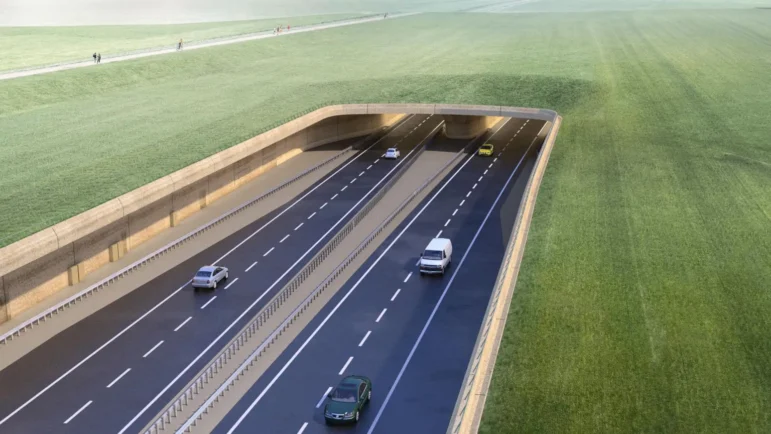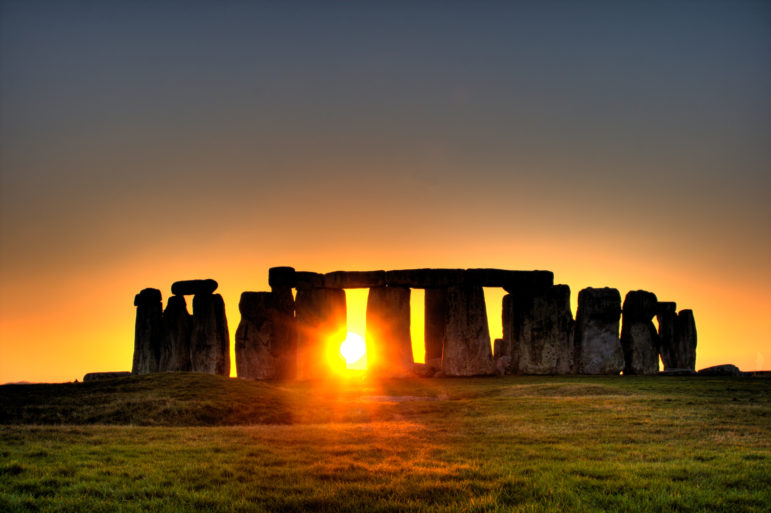LONDON – Stonehenge has again been in the news recently, for two main reasons. We covered these in the last two weeks in The Wild Hunt, but here is a re-cap along with Pagan reactions.
The first of these is that the change of government has led to some major road plans, brought in by the outgoing Conservative administration, being allegedly scrapped due to budgetary reasons. Incoming Labour has deemed them to be too costly, and with a large hole in the country’s finances, the new administration may feel that they can no longer go ahead. The tunnel beneath the henge site, to redirect the A303 carriageway, is one of the projects that has reportedly fallen under Labour’s axe, although this will not be confirmed until the case goes before the Court of Appeal and a new Budget is announced in the autumn.
The second of recent Stonehenge stories is the scientific finding that the Altar Stone originated in Scotland rather than Wales as previously thought.

The proposed A303 tunnel project under Stonehenge. [Source: National Highways
The Stonehenge tunnel
The Wild Hunt reported extensively on the project and the recent scrapping of the A303 project that crosses Salisbury Plain past Stonehenge.
Organisations such as the Stonehenge Alliance, which has been campaigning against the new road, says that it is ‘delighted,’ but local MP Danny Kruger has told the BBC that
“Many residents in Wiltshire will be deeply disappointed that the project to relieve the horrendous traffic congestion through our villages has been axed. If this report is true is it essential that the Government comes forward with a credible alternative plan – funded by the savings from scrapping the tunnel – to improve the road network around the A303. The Government must now set out how it will help our towns and villages cope with the volume of cars and lorries that clog up our roads.”
Cllr Mark Verbinnen, Wiltshire Councillor for Amesbury and Bulford, has said
“It is now widely speculated in press and political circles that the new Labour chancellor will announce tomorrow that they plan to scrap the A303 tunnel project. I personally am most disappointed because of the huge investment that was promised to the Amesbury Area, which I have been lobbying for, including in public facilities. There are many who will be happy with this announcement I’m sure, but still no solution will be forthcoming from this new government.”
We will report again on the Court of Appeal findings in due course. Campaigners against the tunnel say that if it has been cancelled on the grounds of affordability and not on the basis of archaeological reasons, there is a possibility that plans for a tunnel might reappear under a future government when funds improve, so they will be keeping up their efforts to ensure that the tunnel does not happen. Meanwhile, local officials say that, as above, something still needs to be done about the levels of traffic congestion around the A303 in Wiltshire.
“I’ve been part of Stonehenge Alliance for over 20 years writing and presenting evidence against the road proposals because of the landscape and visual impacts.” wrote Andy Norfolk, folklorist, historian and writer. “I did try to introduce a new concept to the planning system/”
Norfolk suggested that a new system include issues such as
- documentation – recent/contemporary use and relevance (e.g. stuff written about say Rollright)
- documentation – historic – (e.g. folklore, myths, legends, historic use for religious/spiritual purposes)
- group value – (e.g. set in a landscape of many related sites having spiritual/religious significance)
- survival – in a condition which evokes a spiritual or religious response
- diversity – has more than one feature evoking such a response (e.g. Avebury I suppose)
- accessibility – well we need to be able to get there to respond
- setting – non-intrusive surroundings, preferably natural
- human presence – e.g. burials
Norfolk said “didn’t work – I don’t think the planners understood the idea of Spiritual Interest Value (based on the Monument Interest Value method used by English Heritage)”

Mid-winter sunrise – simonwakefield – https://www.flickr.com/photos/simonwakefield/3149066878/ ), CC BY 2.0, https://commons.wikimedia.org/w/index.php?curid=6029740
The Stonehenge Altar Stone
In other henge-related news, there have been some exciting developments relating to the origins of the Altar Stone of the monument. Most people will be aware of longstanding claims that some of the stones that constitute the henge, such as the sarsens, appear to have been brought to Salisbury Plain from Pembrokeshire in South West Wales. However, Professor Nick Pearce from Aberystwyth and others have proved that the recumbent sandstone megalith of the Altar Stone could not have had its origins in Wales. Until now, there has been a question as to where, in that case, it did come from. A review of the findings can be found in Pagan Community Notes for the week of August 15, 2024.
Briefly, an article published in Nature in mid-August makes compelling claims for an entirely different origin for the Altar Stone.
The authors of the study wrote, “the Altar Stone was anthropogenically transported to Stonehenge from northeast Scotland, consistent with evidence of Neolithic inhabitation in this region. Whereas the igneous bluestones were brought around 225 km from the Mynydd Preseli to Stonehenge, a Scottish provenance for the Altar Stone demands a transport distance of at least 750 km. Nonetheless, even with assistance from beasts of burden, rivers and topographical barriers, including the Grampians, Southern Uplands and the Pennines, along with the heavily forested landscape of prehistoric Britain, would have posed formidable obstacles for overland megalith transportation.”
There has been speculation that the stone was carried to the Plain by glaciation, not human effort, but geologists say that this is unlikely, as the ice would have moved in a northerly direction. Senior curator at English Heritage, Heather Sebire, told the press that
“My gut feeling is that it came over land and it possibly took a long time and was not necessarily in one fell swoop. Getting places as quickly as possible is a modern concept – we’re always in a hurry. Their mindset was probably very different. You can think of it as a pilgrimage. Experiments have been done trying to bring the equivalent of the bluestones on rafts across the Severn. I’m afraid none of them have been successful. They sank.”
However, a definitive answer to the question of how the stone arrived on Salisbury Plain remains, for now, elusive. The origins of Stonehenge still retain an element of mystery.

Stonehenge (Photo Credit: MJTM)
Pagans React
I have been visiting Orkney since 1977 and I am not surprised by the connection between what is clearly Neolithic Central and Stonehenge. In the excavation of Durrington Walls, Wilts, where Neolithic visitors assembled and feasted at Midwinter near Stonehenge, pig bones from Scotland were found, showing that pilgrims representing their region were attending Midwinter rites at Stonehenge at the time when it was ceremonially active. This speaks of a much wider connection of Neolithic people with a major ceremonial site, and that Stonehenge was not just a regional centre. Anyone who has been to Orkney will immediately understand its primal importance to Neolithic ceremonial life at the time. Rather than being a mere outlier set of islands, Orkney was actually the hub and inspiration for ceremony. Orkney’s stones were already being used to create circles and ceremonial complexes before Stonehenge, because it lost its trees early on. Who is to say that the builders of Stonehenge required one of these Orcadian stones to place at the centre of their henge because they venerated this Orcadian primacy?” (Caitlín Matthews, co-author of Walkers Between Worlds.
Caitlin Matthews, writer and Shamanic practitioner
![]()
for the British Isles and Ireland, at least, Orkney is likely the hub from which the Neolithic agricultural package was disseminated. I strongly suspect that a new religious belief is intrinsic to that agricultural package, along with domesticated plants, animals, and grooved ware pottery. The beliefs were probably a solar cult with ancestor veneration.
This is about the transition from hunter-gatherer-fisher to farmer, a massive revolution, and likely resisted. Orkney is the hub, origin and epicentre (for British Isles and Ireland) and it is entirely reasonable that it be represented at all manner of sites, including Stonehenge (if the stone is from Orkney, the potential geology covers a wider area). The Ness of Brodgar is likely the training / power base for the export of the ‘Orkney farming package’.
It’s odd now to think of these islands as the pivot but Orkney wasn’t a backwater then, and wasn’t in other historical periods, such as the Norse period, either.
Helen Woodsford-Dean, celebrant and Orkney resident
![]()
The Ness of Brodgar excavations show that the amazing complex there was at its peak as Stonehenge was also during its most important stages.
Andy Norfolk, folklorist, historian and writer
![]()
Modern Druids treasure the interconnectedness of things – holy and ordinary, past and present, humankind with the rest of nature. Stonehenge, and the festivals celebrated there, have long been felt to be a physical manifestation of that principle. The henge is the hub of the wheel that spins the diverse fibres of experience into the skeins of fate, across the island of Britain. It is deeply inspiring that cutting edge archaeology has shown that the ancient builders of Stonehenge were also using the site to make connections, across great distances, further indicating the sophistication and eminence of the Orcadian ritual centre at the Ness of Brodgar.
Dr Jonathan Woolley, Druid
![]()
To be honest this has not surprised me in the slightest – the evidence for the mid to late Neolithic as a time of considerable social and technological sophistication has been there for a while, and a ten day walk between Wiltshire and John O Groats is nothing to a pre-modern human, particularly someone who lives a pastoral existence. I’d have been more surprised if there had been no connection. I doubt that the stone was transported the whole distance overland, though. Now the archaeologists need to find the boats.
Jack Wolf, author and Druid
![]()
We already guessed some of the builders may have been Orcadian from the pig bones. So they brought their pet rock with them. Were they red-heads by any chance? (Asking for an imaginary friend.
Tim Hawthorn, Pagan
The Wild Hunt is not responsible for links to external content.
To join a conversation on this post:
Visit our The Wild Hunt subreddit! Point your favorite browser to https://www.reddit.com/r/The_Wild_Hunt_News/, then click “JOIN”. Make sure to click the bell, too, to be notified of new articles posted to our subreddit.
